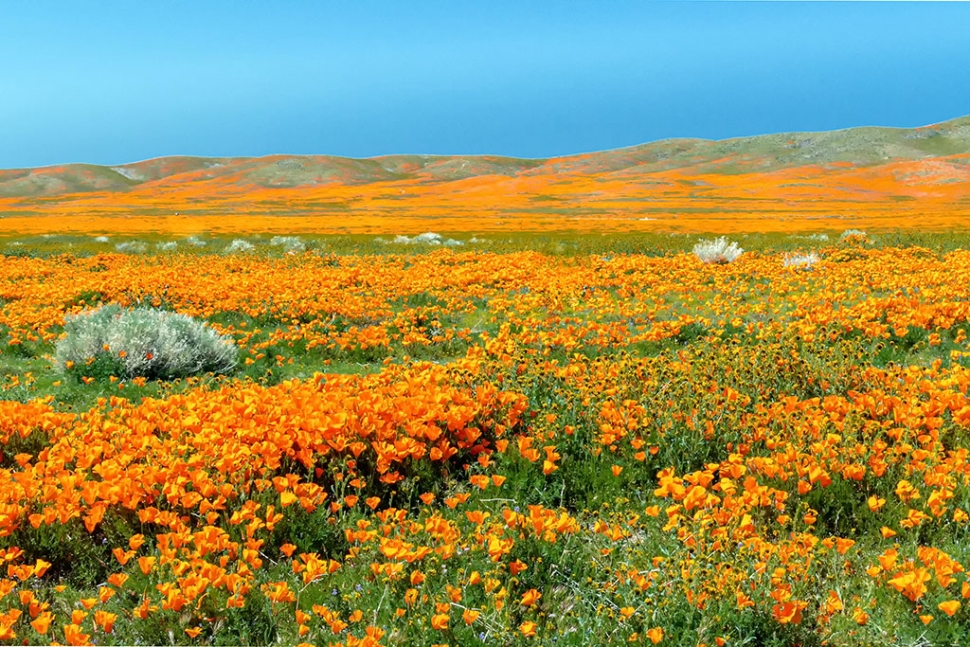|
Focus on Photography
 Photo of the Week: "Antelope Valley poppy bloom" by Bob Crum. Photo data: Canon 7DMKII camera, manual mode, Tamron 16-300mm lens @37mm with polarizing filter, Exposure; ISO 400, aperture f/11, 1/250sec shutter speed. By Bob Crum — Wednesday, April 29th, 2020
Their Essence Eludes Capture
 Bob Crum Shelter in place! Stay home! Arrrrgh. I need relief if only for a few hours! I camouflaged my truck and in stealth mode drove up to the Antelope Valley. Resistance photographing a grand poppy bloom is futile. I've been photographing the Antelope Valley poppies for years. Some years several fields are so full of California poppies it looks like someone painted the earth a bright orange. But it changes year to year. One year, poppies filled field A. The following year, nothing or very few flowers in A. A quarter-mile south, field B that had none last year is full of flowers. Even the bloom at the Poppy Reserve varies significantly from year to year. Rainfall? Temperature variations? Sun flares? Nature! Weather and timing are crucial for a successful poppy photo shoot. Poppy tapered buds open into flowers with four satiny petals. A behavior called nyctinasty causes the flowers to close on cold nights and cloudy or windy days, opening the following morning again, weather permitting. One theory is that they do it by "pumping water out of the flowers, a clever case of wilting," says landscapeofus.com. But without meteorological sensors, how does the plant know what to do and when to do it? Hmmm. The shooting window is often narrow. Arrive too early on a chilly morning and you'll find poppies closed, only opening as the sun warms them. Like the precision of a train schedule, the winds gradually increase speed at about 2 p.m. and the flowers begin their closing ritual. I made all photos with a polarizing filter on the lens primarily to reduce petal glare, not necessarily for color enhancement. Enhanced color saturation not needed. Driving south on one of the main roads, I saw a large area of orange to my right. I turned onto a dirt road and soon turned into a small clearing in the field. I was instantly awash in a sea of gorgeous orange flowers all around me. Never have I seen such intense orange! Even the foliage was a healthier blue/green color. And the plants here much larger than usual. With awe and adoration, I sat down on the earth dampened by recent rain. Photographing the scene can wait. Looking out over the field of beautiful flowers, my mind, as it always wants to do, automatically began to describe a poppy. Foolish mind! Such splendor best fully apprehended without useless, meaningless words. Philosophically speaking, intellectual descriptions are mere concepts, not the essence of the flower. As I continued to gaze upon the glorious scene, my mind eventually became pleasantly silent. Without effort and eyes open, I meditated. An indescribable peace comes with intuiting that my life source and that of the flowers is of the one Consciousness (God if you prefer). I know not how long I remained in this meditative state; the concept of time becomes irrelevant. Eventually, back in the manifest world of presumed reality, I enjoyed profound tranquility. I stood up, raised my camera and made a few photos of the splendor. Wonderful it would be if the camera could capture the true essence of the gorgeous flowers. Photoing the poppies is always satisfying. However, because of my now limited mobility, it was frustrating this year. Even with a portable oxygen concentrator backpack, I couldn't wander freely for the preferred composition. I had to shoot from my truck most of the day -- roll down the window -- shoot -- roll up the window -- drive to the next area. Hopefully the photo of the week, in some measure, illustrates the majesty of nature. Happy photoing! Send questions, suggestions or comments to: focusonphotography@earthlink.net |
